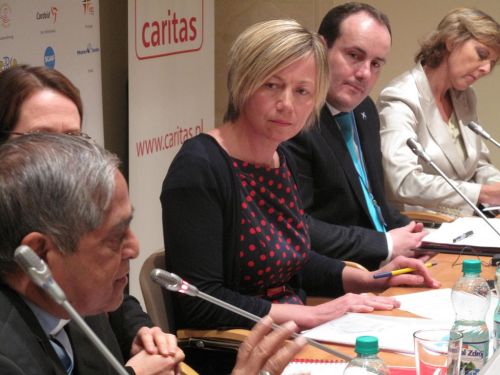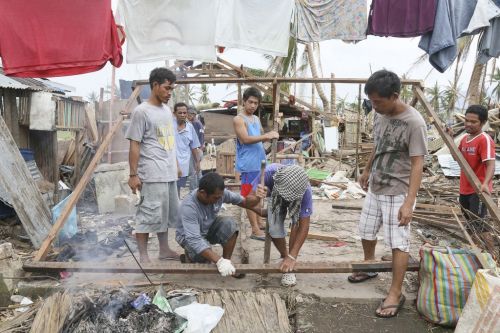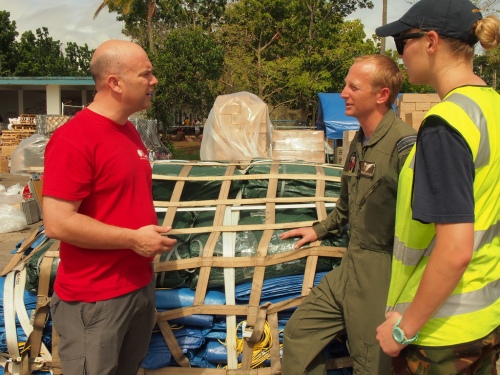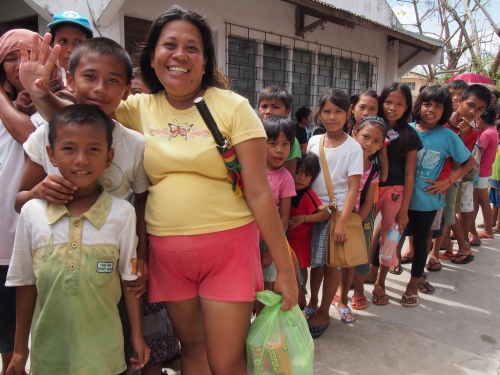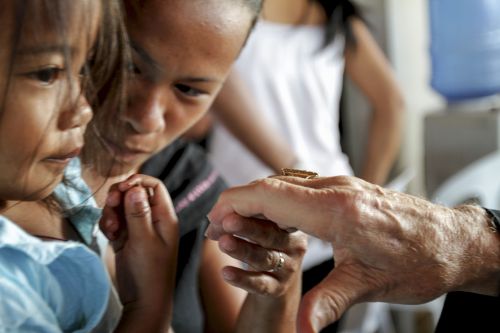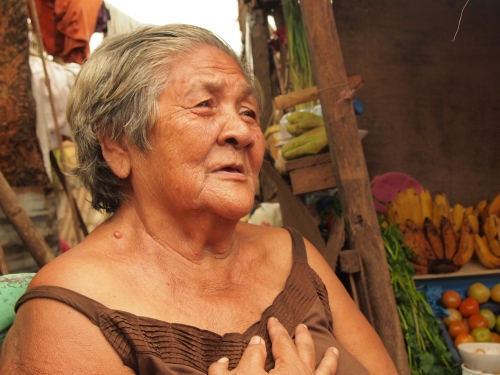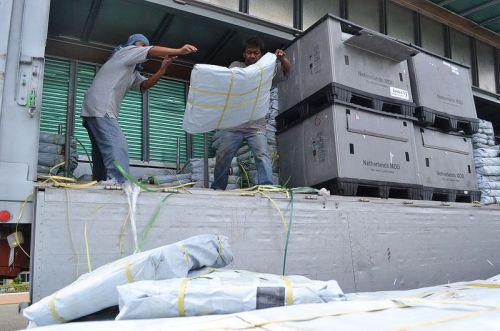
Fr Mark Granflor, director of the social action office of the archdiocese of Capiz (the diocesan Caritas), delivering food aid. Credit Ryan Worms/Caritas
“I didn’t want to leave my parishioners. But when the roof of my house was blown away and the wind shattered the windows, I had to get away,” said Fr Jose Taz Lasola from the Padre Pio mission in Roxas, on the island of Panay, one of the areas most seriously affected by the violent Typhoon Haiyan.
Standing where his wood and bamboo church once was, Fr Jose looks emotionally at the destroyed statue of a saint. Nothing can be salvaged from the building.
“My community of 800 parishioners is strong and united,” he said. “The families are busy building shelters in the remnants of their homes, but volunteers have already come to help me clear the debris. They want to rebuild their church, a place for gathering and unity. But first of all, the families need to get a roof over their heads and resume work.”
Fr Mark Granflor, director of the social action office of the archdiocese of Capiz (the diocesan Caritas), surveys the extent of the damage.
“Tacloban and the island of Leyte have received wide media coverage. But Panay mustn’t be forgotten. Here too, families have been very badly hit. More than 147,000 people have been affected, and you only have to look around to see that people need help,” he said.
In the coastal area of Roxas and in the town of Panay, almost all the houses have been severely damaged.
As rain starts to fall, the children play among the remnants of the fishing boats. Fishing is one of the main activities in this region. As in other parts of the Philippines, many fishermen have lost their boats and nets.
Fr Granflor said however, “Nothing seems to dampen their spirits. Yesterday I met a fisherman and when I asked him if he needed anything he said no and that everything was fine. Sure, he’d lost his home and his boat, but a more fortunate neighbour lent him his own boat when he’d finished fishing. So he was able to go fishing and bring back some fish for his family to eat, sell a little and start getting back on his feet.”
This is one of many stories that illustrate the courage and resilience shown by the victims of Typhoon Haiyan.
“These people may have lost their homes and their clothes, but they haven’t lost their dignity,” says Father Mark.
The staff of the social action office of the archdiocese of Capiz have travelled to the remotest areas to carry out an accurate assessment of the damage caused by the typhoon and the needs of the population.
Teams of volunteers were rapidly set up to prepare bags of food items and clothing for distribution.
Shella and James immediately offered themselves as volunteers. While James loads two trucks with food that will be distributed during the day, Shella prepares bags of clothing for another distribution that will take place the following day.
“Helping my community does me good,” she said. “It makes me feel useful and takes my mind off what I’ve lost. You can always find someone who’s lost more than you have.”
The trucks are loaded, and they head off to a community behind the town of Panay. Along the way, farmers are already repairing their rice fields. “Agriculture is the second most important activity after fishing,” said Fr Mark.
This sector has also been badly hit by the typhoon. While the rice fields can be restored quite quickly, it will take years for the palm trees and coconut palms to be productive again.
The people are gathered in front of the roofless church. In this community the parish leaders have drawn up a list of 250 families that should receive aid on a priority basis. Each family will be entitled to a bucket containing three kilos of rice and potable water.
The distribution takes place calmly until sunset. The people who leave with enough food to feed their families for two days are grateful. However, they would also like to receive aid to rebuild their homes, or at least have plastic sheeting and ropes to strengthen their temporary shelters.
The next day the same message echoes from the community of Linateran, a neighbourhood in the small town of Panay.
“I need a roof to shelter my family,” said Alex, a taxi driver who has come to get a bag of clothes from the distribution organised by the diocesan Caritas. With Prince, the young son he’s carrying in his arms, he said, “If we could rebuild our homes, then we’d be able to move forward. Conditions are currently very difficult, and I’m afraid my son might get sick.”
Several members of the community ask us to visit the neighbourhood with them in order to see the extent of the damage for ourselves. The destruction is all too real, and all the houses we see still standing have suffered substantial damage.
In front of her house, Myrna, a mother of four children, tries to recover the nipas, the clusters of palm leaves that are traditionally used to make roofs.
“We’re still lacking everything, and we haven’t received any aid from the government,” she said. “But in our community we help each other out as much as we can. When one of has a little food, we share what’s left over with neighbouring families. But what can we do about our homes? We have no money to buy building materials. So we do what can. All the aid you can bring us is welcome.”
This week Caritas will receive 13,000 plastic sheets, which will be distributed in the affected areas. They are in addition to the thousands that have already been distributed on the island of Leyte.
“It’s true that Tacloban and the island of Leyte were devastated,” says Father Mark, “but the other regions the typhoon passed through seem to have been forgotten. Here too, people are suffering.”
Despite the great solidarity that unites them, often the survivors of Typhoon Haiyan can only rely on international aid for any hope of relief. And this aid has to be channelled to all the regions affected by the disaster. That’s what the members of the Caritas confederation are striving to do.

